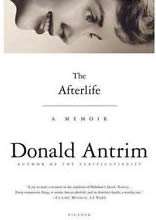The Afterlife: A Memoir
 First edition cover | |
| Author | Donald Antrim |
|---|---|
| Country | United States |
| Language | English |
| Publisher | Farrar, Straus & Giroux |
Publication date | 2006 |
| Media type | Print (hardcover & paperback) |
| Pages | 193 pp |
| ISBN | 978-0312426354 |
The Afterlife is an American memoir written by Donald Antrim. The book became a finalist for the National Book Critics Circle award in 2007.[1]
The memoir's primary theme is Antrim's torturous relationship with his alcoholic, manipulative, and mentally ill mother, Louanne Antrim (née Self).[2][3] Relationships with other members of the author's family are explored, but all of these relationships are presented as essentially subordinate to Antrim's relationship with his mother.[4][5]
Thematic and stylistic contents
Writing The Afterlife marked a departure for Antrim away from the comic surrealism of his early novels into more difficult, emotionally earnest, traditionally realist prose.[6][7]
Donald Antrim: What I gained [while writing The Afterlife] was something related to writing into emotion, into my own feelings, into what I imagined other people's feelings to have been. The novels are very much card houses. They're conceptually driven constructions. And to some degree they contain some kind of emotional core. But with the memoir, the emotional lives of the people I'm writing about, my own emotional life as I was writing, these things were much more on the surface and much more pressing to me...
Q: Your stories that have appeared in The New Yorker since the memoir are different from what you were doing before. Your earlier fiction has been sort of squarely in the realm of postmodern literature, and the new work is much more straightforward. I wondered if the memoir is a kind of dividing line for you.
Donald Antrim: It is.[8]
The book's action maps Antrim's attempts to trace the roots of his own depression, anxiety and trouble with women by examining his relationship to his life-threateningly alcoholic mother, Louanne, who wrecked two marriages to the same man and irrevocably scarred her children. In the most comical of the book's seven associatively organized parts (most were New Yorker pieces), Antrim tries, shortly after Louanne's death in 2000, to buy himself a new bed, only to be goaded by guilt and paranoia into buying and returning several.[9] Another piece focuses on a bizarre kimono Louanne, a highly skilled seamstress, made late in her life, complete with sewn on giraffe, mystic birds and potpourri pouches. In the powerful final episode, during Louanne's last big hallucinatory drunk, while dragons fly about her head, Antrim must find the strength to become his mother's parent.[10]
Psychodynamic and Oedipal themes are frequently alluded to in the text, though they are not deeply or literally explored. Primarily the narrative is composed of the material symptomatology resulting from toxic intrafamilial relationships: Donald Antrim's inability to purchase a mattress,[9] his Uncle Sam's need to carry the totems of his masculinity with him in his car everywhere he went,[11] his mother's boyfriend's need to identify a painting,[12] his mother's raging alcoholism which may have been traceable to her mistreatment by her own mother in the form of Munchausen syndrome by proxy,[13] his grandfather's alcoholism and inability to curb his wife's psychological abuse. In The Afterlife [Antrim] protects his mother even as he unsparingly enumerates her lapses and shortcomings, at once paying tribute and enacting a perfect revenge. As a child, he was forced to live his life on her terms; but it is he who will dictate the terms of her immortality. The book begins with Louanne's death and ends with a vision of her ashes being transported to a final destination off the Florida Keys. Throughout "The Afterlife" she is dead; the only existence she has—partial, shadowed, unfinished—is the one granted by her son within its pages."[14]
Early versions and original publications
References
- ↑ Sternberg, Sybil (September 2006). "NBCC Memoir Finalist: Donald Antrim's The Afterlife". The National Book Critics Circle. Retrieved 6 March 2014.
- ↑ "The Afterlife". Kirkus Reviews. June 24, 2010. Retrieved 6 March 2014.
- ↑ Metcalf, Stephen. "Elegies for Parenthood". Slate Magazine. Retrieved 6 March 2014.
- ↑ Antrim, Donald. "In my mother's bed". The Guardian. Retrieved 18 February 2014.
- ↑ McNair, Charles. "Donald Antrim: The Afterlife". Paste Magazine. Retrieved 6 March 2014.
- ↑ Scott, A.O. (June 18, 2006). "Son and Survivor". The New York Times. Retrieved 6 March 2014.
- ↑ Barrodale, Amie (May 30, 2012). "Bookforum talks to Donald Antrim". Bookforum. Retrieved 6 March 2014.
- ↑ Smith, Drew (February 2014). "Donald Antrim". The Believer. Retrieved February 18, 2014.
- 1 2 3 Antrim, Donald (June 17, 2002). "I Bought A Bed". The New Yorker. Retrieved 18 February 2014.
- ↑ ""The Afterlife" by Donald Antrim". Publisher's Weekly. Retrieved 18 February 2014.
- 1 2 Antrim, Donald (Feb 17, 2003). "AKA Sam". The New Yorker. Retrieved 18 February 2014.
- 1 2 Antrim, Donald (Dec 22, 2003). "Church". The New Yorker. Retrieved 18 February 2014.
- 1 2 Antrim, Donald (Dec 25, 2000). "Black Mountain, 1977". The New Yorker. Retrieved 18 February 2014.
- ↑ Scott, A.O. (June 18, 2006). "Son & Survivor". The New York Times. Retrieved 18 February 2014.
- ↑ Antrim, Donald (April 21, 2003). "Ad Nauseam". The New Yorker. Retrieved 18 February 2014.
- ↑ Antrim, Donald (March 15, 2004). "The Kimono". The New Yorker. Retrieved 18 February 2014.
- ↑ Antrim, Donald (September 3, 2007). "A Man In The Kitchen". The New Yorker. Retrieved 18 February 2014.